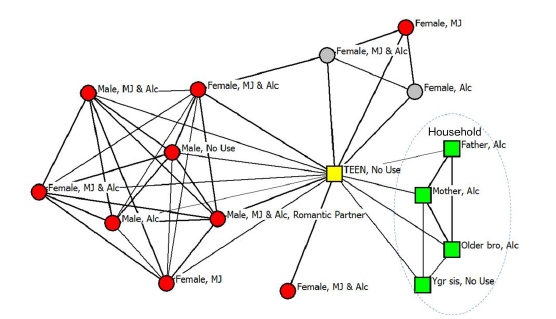Is the Course of Recovery Impacted By the Substance-related Behaviors & Attitudes of Their Social Networks?
Social networks variables – for example, how many friends does an individual have that use drugs or encourages/discourages drug use – are strong predictors of abstinence and remission rates among adults.
However, the field knows comparatively less about how these variables operate in adolescents. Perhaps more importantly, researchers’ conventionally study network composition (e.g., number of drug using peers) that certainly advance recovery research, but cannot address the complexity and richness of social network influence.
While having more abstinent friends is a powerful predictor of positive recovery outcomes, optimal ways to modify underlying psychological constructs in this regard, like motivation to and perceived difficulty with making changes to one’s peer group, are not yet clear.
Thus, in order to more fully explain the role of social networks in SUD recovery among adolescents, Chung and colleagues investigated social network composition and structure among 155 adolescents (age 14 to 18; 75% male) with alcohol or marijuana use disorders who attended abstinence-based, outpatient SUD treatment. In this case, structure was defined with respect to degree (number of individuals – a minimum of 10 – who are “most important to you”) and density (how close these network members are to one another).

Note: Analyses were cross-sectional, meaning the descriptions below refer only to the adolescents’ social networks and recovery characteristics as they entered treatment.
They found that the number of density, and the proportion of peers abstinent from alcohol, predicted severity of alcohol use disorder symptoms. For marijuana, only proportion of peers abstinent predicted the severity of marijuana use disorder symptoms.
Consistent with other recovery studies, abstinence motivation and treatment goal (e.g., temporary vs. longer-term abstinence) predicted how motivated someone is to reduce the number of substance users in their network (for both alcohol and marijuana).
Finally, abstinence motivation, as well as number and density of the peer network, predicted perceived difficulty in reducing contact with alcohol users, and proportion of abstinent peers and number and density of the peer network for reducing contact with marijuana users.
IN CONTEXT
Social networks are among the most powerful variables in understanding whether and how people recovering from SUD. For example, 12-step mutual-help organizations tend to mobilize positive outcomes by helping people add pro-abstinent members and reduce pro-using members to their social networks. Chung and her co-authors showed that by adapting constructs from other areas of social and psychological science, such as social network density, we can add to our understanding of SUD recovery.
Given that about 6 in every 100 adolescents is diagnosed with an SUD, these authors offer an important contribution to the literature by extending prior findings to adolescents in outpatient treatment.
They showed adolescents’ motivation to abstain, and the extent to which their peers abstain from alcohol and other drugs are important predictors of positive outcomes. Intuitively but importantly, increasing adolescents’ abstinence motivation may increase their motivation to make pro-recovery changes to their peer networks.
The most unique contribution here is that adolescents’ effective navigation of their friends’ connections to one another can also be an important pathway to enhancing their confidence in making these pro-recovery changes. One important caveat is that authors focused on alcohol and marijuana use, however among treatment-seeking adolescents about 20% report another “drug of choice”; thus it is not clear whether these findings might generalize to this sub-group.
CITATIONS
Chung, T., Sealy, L., Abraham, M., Ruglovsky, C., Schall, J., & Maisto, S. A. (2015). Personal network characteristics of youth in substance use treatment: Motivation for and perceived difficulty of positive network change. Substance abuse, 36(3), 380-388.

